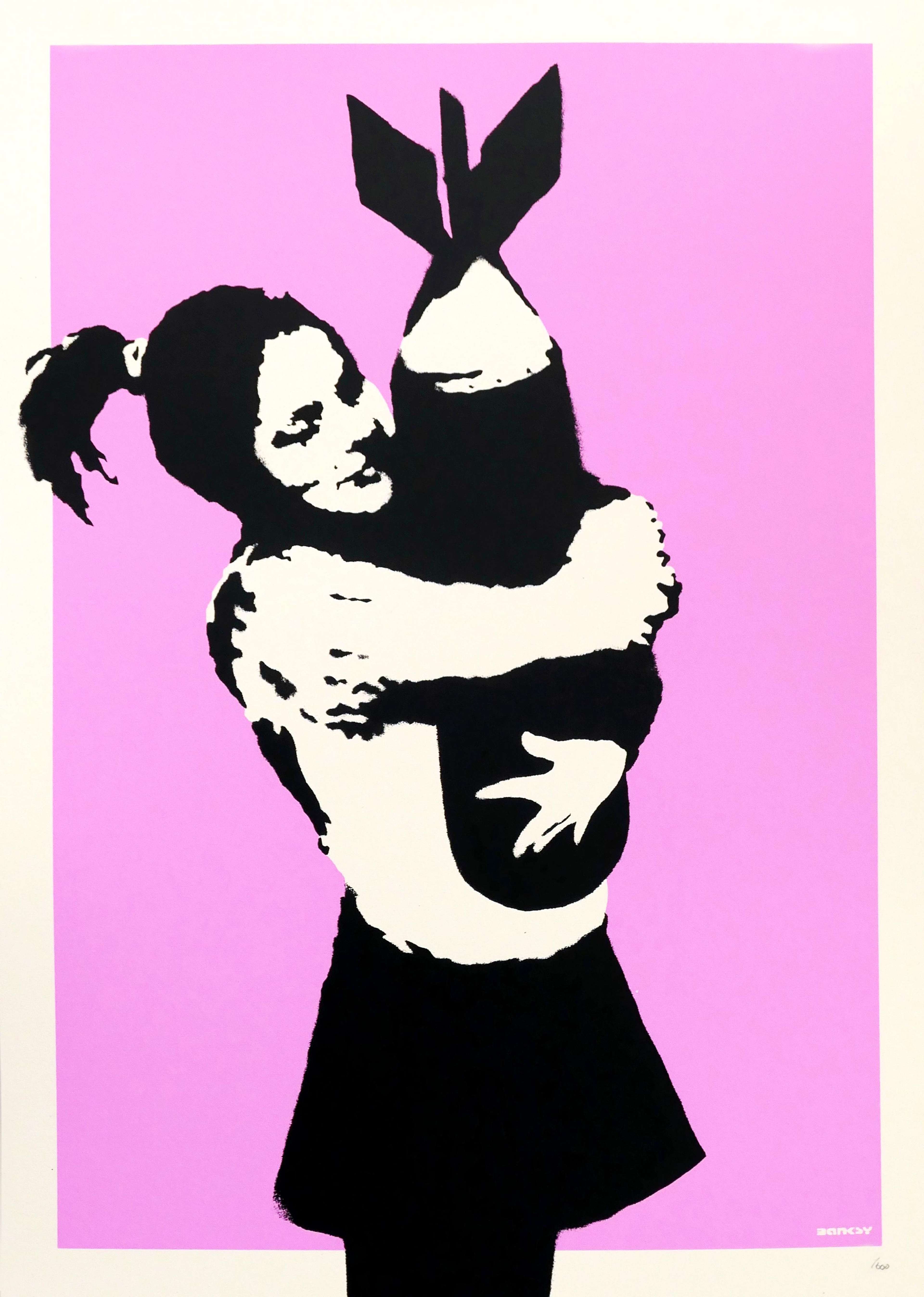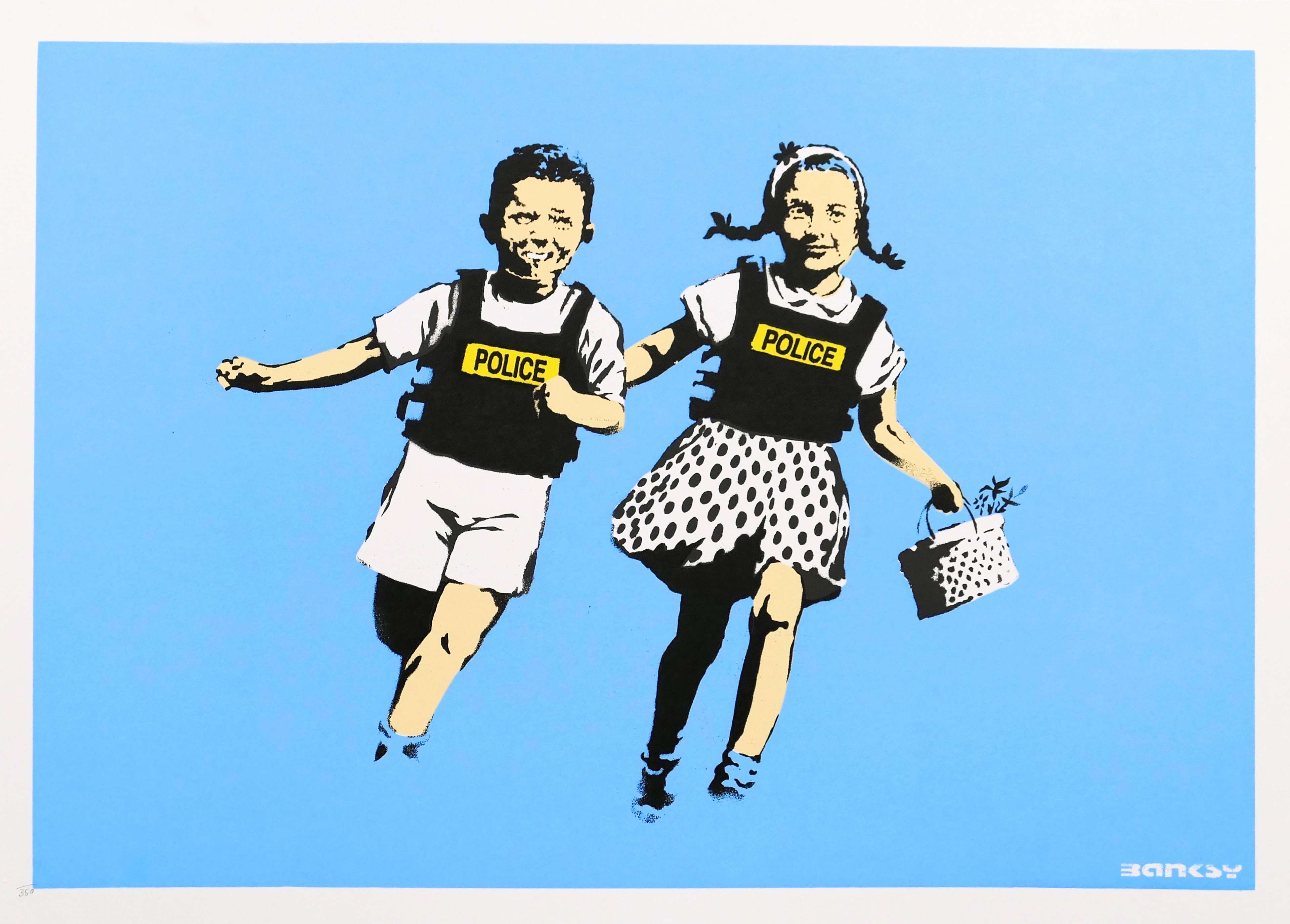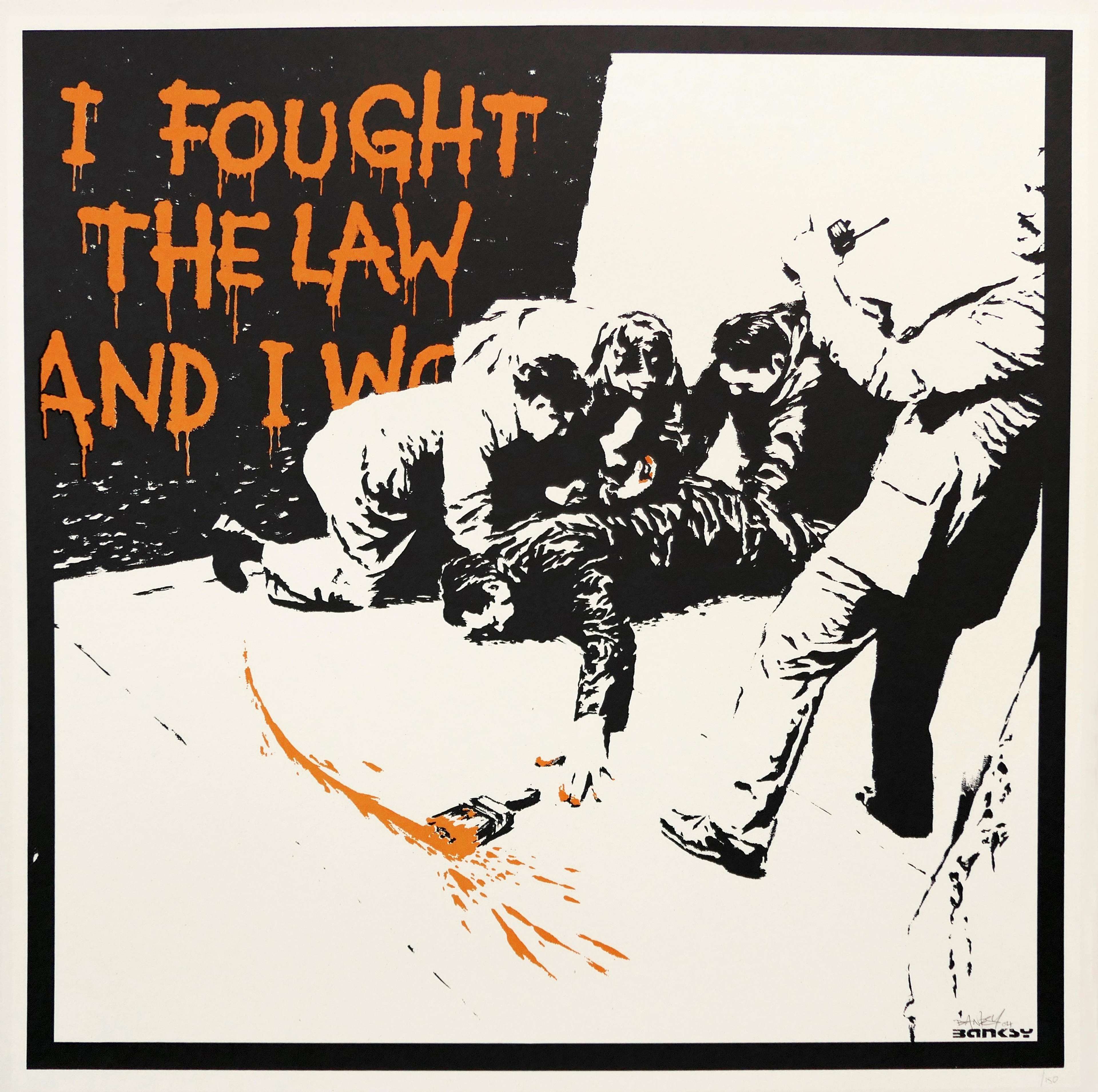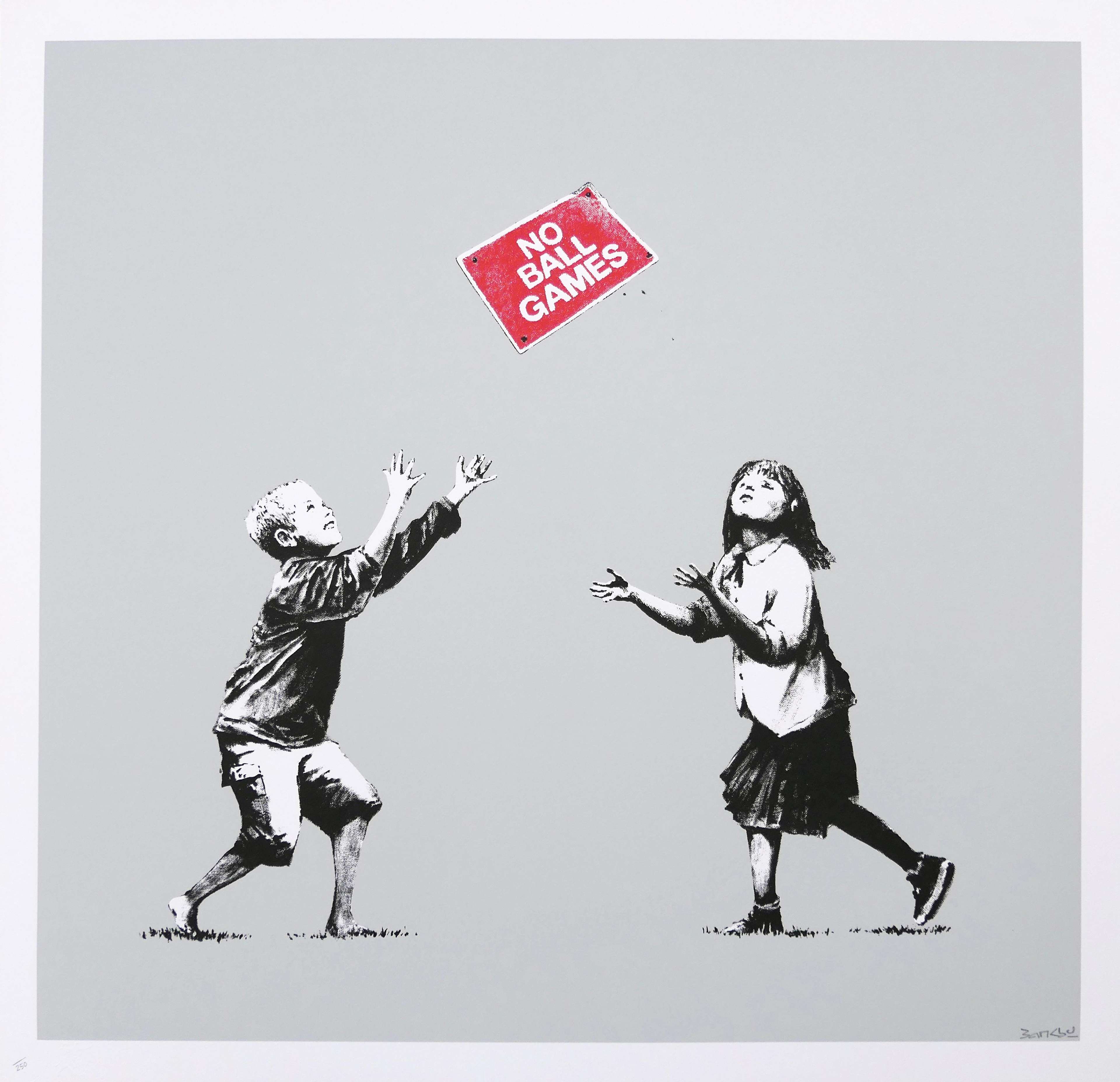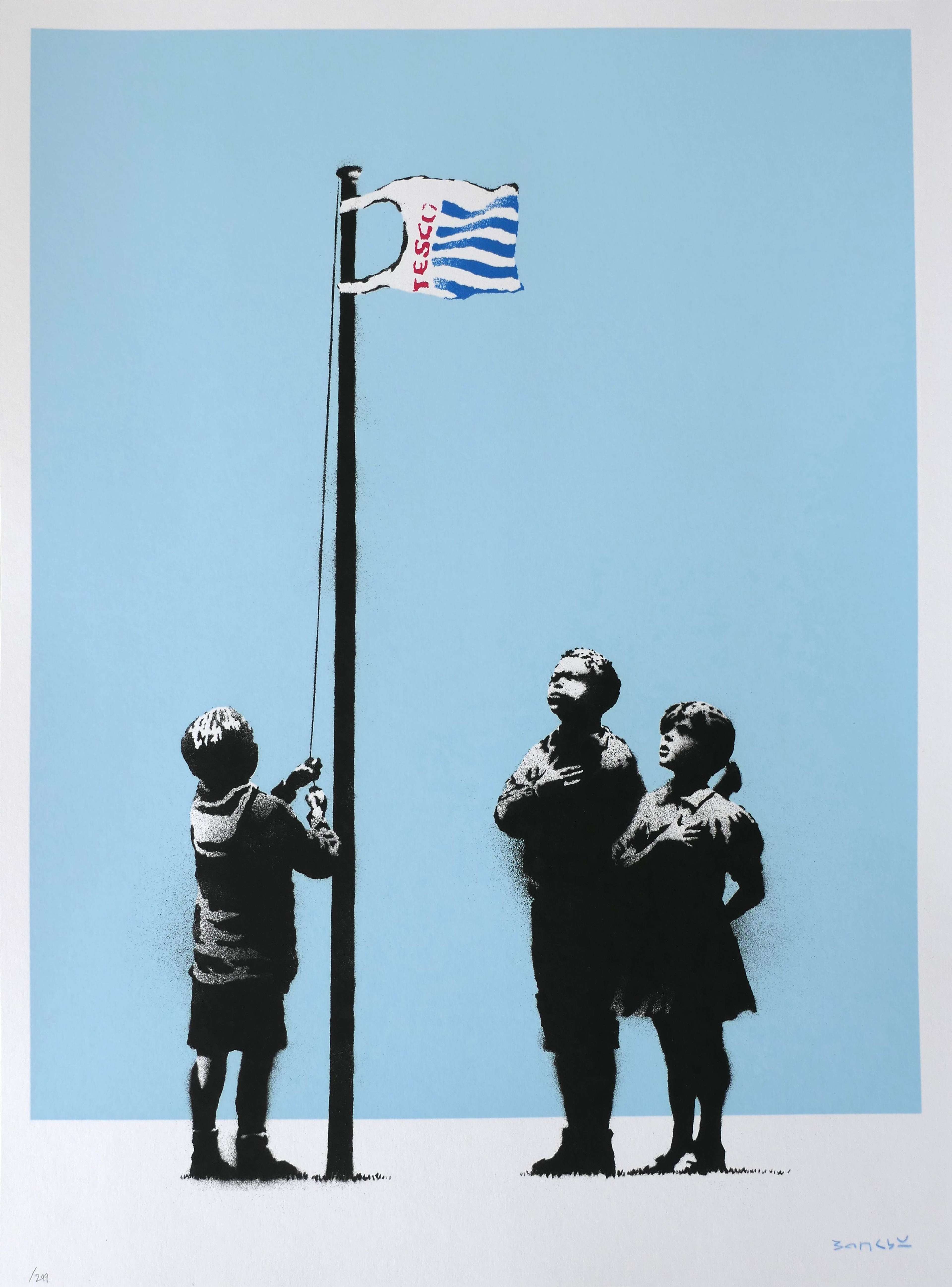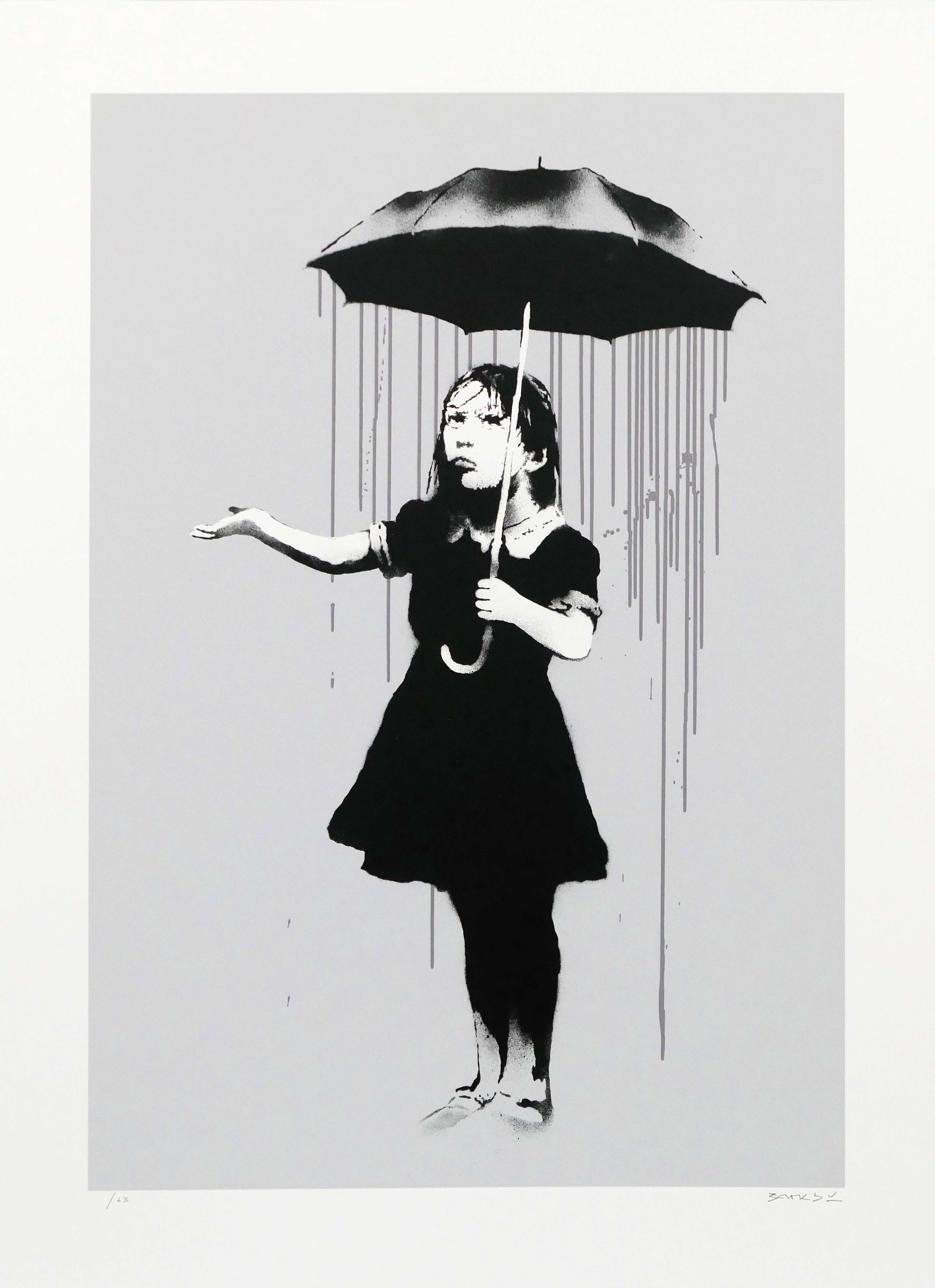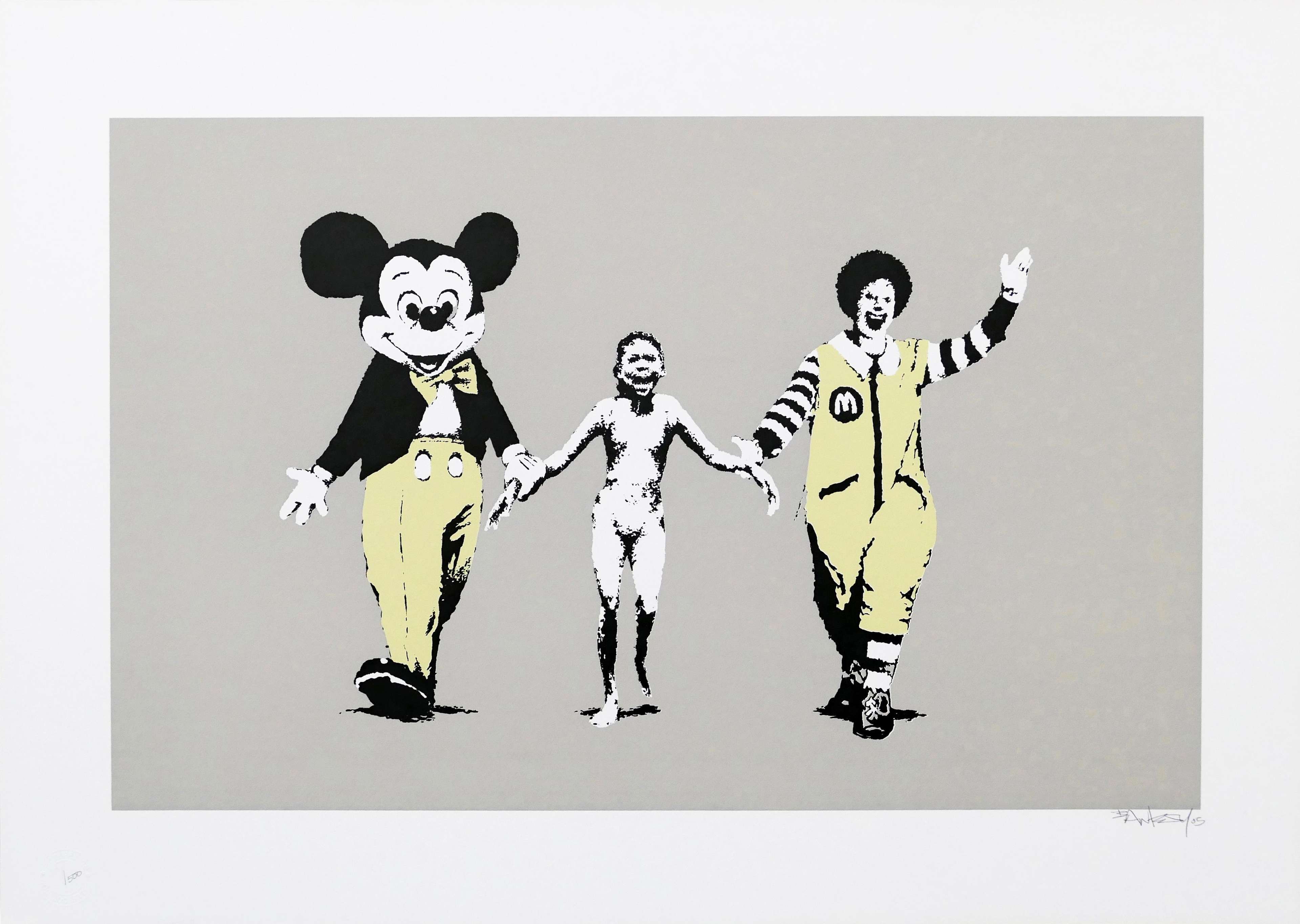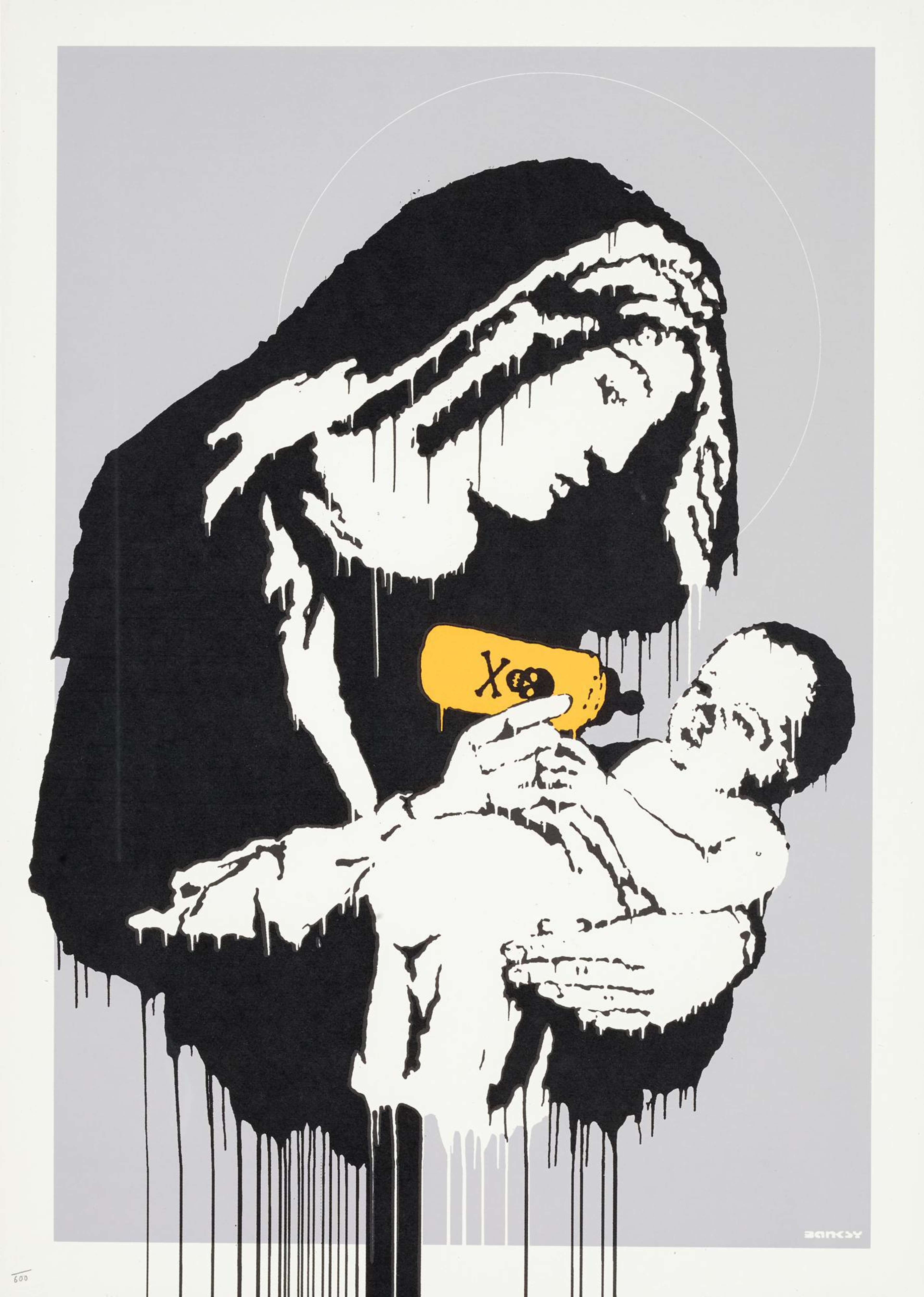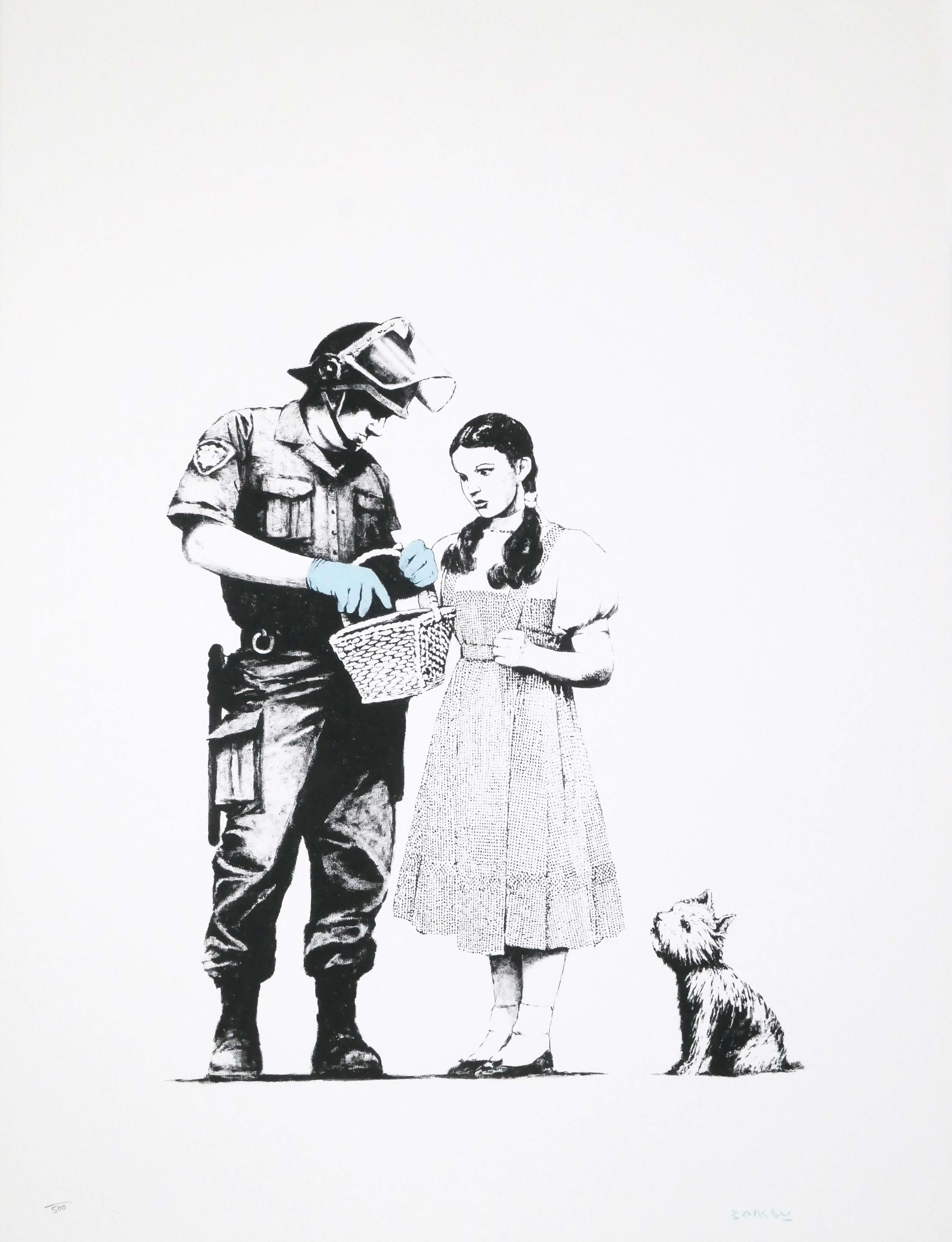Disillusioned Youth: The Theme Of Childhood In Banksy’s Prints

 Kids On Guns © Banksy 2003
Kids On Guns © Banksy 2003
Banksy
269 works
From the fairytales of the Brothers Grimm to William Blake’s Songs of Innocence and Experience, children have long been the protagonists of dark tales that turn a mirror on the ills and inequalities of society. Banksy, a master of telling a story with the sparest of stencil marks, knows how powerful the image of a child can be in evoking empathy in the viewer and often draws on the universal experience of childhood in his murals and prints.
While Banksy’s artworks about childhood feature children who often seem mournful or lost, they can also be figures of joy and humour in works that embrace satire to poke fun at those in power.
Despite frequently expressing his dislike for advertising, Banksy is nevertheless adept at utilising its visual language to draw the attention of the viewer, whether in a mural or a print. Throughout his oeuvre he employs well known cultural, religious and topical figures and motifs from the world around him to proliferate his anti-establishment message. Here we take a look at some of his most important works featuring the theme of childhood, from his heartbreaking Girl With Balloon to the more sinister Bomb Hugger.
Why does Banksy create art about childhood?
A universal symbol of innocence and purity, the child is the perfect vehicle for the messages held within Banksy’s artworks. Instilling the viewer with a need to protect and comfort, the innocuous expression of Banksy’s children become the perfect mask for a more profound or even sinister meaning. In works such as Jack And Jill, a pair of children are shown frolicking against a flat blue background but this is no joyful scene. Their summer outfits are obscured by heavy black bulletproof vests emblazoned with the word ‘POLICE’ and their faces contradict the youthfulness of their body and clothes, lined with age and frozen in an uneasy smile. Here Banksy appears to be commenting on both the lost innocence of the youngest generations who grow up amongst the violence of the 24 hour news cycle and video games, as well as the constant presence of the ‘nanny state’ which puts in place ever more controlling rules and laws, restricting the freedom of children and adults alike.
This theme can also be seen in works such as No Ball Games, where the artist employs irony to make a statement about the effect of this constant surveillance on contemporary youth. And while the nanny state is usually the target of Banksy’s wit, it would appear from his 2005 book Wall And Piece, that the artist also believes that parents are partly to blame for this culture of overprotectiveness too, stating “A lot of mothers will do anything for their children, except let them be themselves.”
In works such as Very Little Helps, children become a way for Banksy to point the finger at two of his most hated establishments, consumerism and nationalism, as well as the governments that invite them in through policies of austerity and strict borders. In this work, three children are shown standing around a flagpole. Instead of raising a flag, one of them is raising a Tesco branded plastic bag while the other two are pledging their allegiance with their hands on their hearts. By placing children at the centre of the image, Banksy softens his message making it work on a subtler level of humour and innocence that draws the viewer in.
Banksy uses children to comment on global injustices
As well as using children to highlight the problems of the UK, Banksy has produced a whole series of artworks that feature endearingly youthful figures to comment on injustices that affect children and adults all over the world.
Nola, also known as Umbrella Girl or Rain Girl, was painted by Banksy on the streets of New Orleans in 2008, three years after the tragic events of Hurricane Katrina. Here the figure of a girl is shown trying to shelter herself from rain only to find that it is the umbrella itself which is causing her to get wet. Offering a commentary on the failure of the US government to protect its citizens during and after a natural disaster, Nola is a powerful work that immediately resonates with the viewer.
In one of Banksy’s more shocking works Napalm, Banksy appropriates the famous and disturbing photograph The Terror of War, taken in 1972 by photographer Nick Ut during the Vietnam conflict. The focal point of the photograph is a nine-year-old girl named Phan Thi Kim Phuc, who runs naked in fear down a road alongside other children and soldiers of the Vietnam Army. In Banksy’s reimagining of the famous image, entitled Napalm, the young girl is now flanked by Mickey Mouse and Ronald McDonald, characters that represent two of the world’s largest corporations. This establishes a disarming juxtaposition in one of Banksy’s most cutting and provocative social criticisms. The horror of the scene is twisted and intensified by the pair of beaming characters, seemingly unconcerned by her distress, forcing the viewer to question the image of benevolence they project.
Girl With Balloon proves the success of Banksy’s childhood imagery
Banksy's Girl With Balloon was voted the nation's favourite artwork in 2017, proving how effective his use of childhood imagery is in resonating and being understood with a large and varied audience. Representing both lost innocence and the importance of holding on to hope even in dark times, Banksy's Balloon Girl, conveys her dual but simple message without overcomplication and with an emotional force—the heightened empathy most of us feel towards children—that is transcendent.
When it first appeared as a mural on London’s Southbank, the now infamous artwork Girl With Balloon was accompanied by the message ‘There Is Always Hope’. It was recreated in Shoreditch, however both works have since been destroyed or painted over. The image lives on in its many iterations, and has become a signature Banksy motif. The work has proved the universality of the girl's innocence and message as it has been adapted and proliferated as a commentary on different topical events: the 2014 conflict in Syria, the 2017 UK general elections and as in the artist’s later reworking, Kids On Guns. Now commodified and repeated ad infinitum on mugs, t-shirts and even estate agent placards, the image has become instantly recognisable, encompassing for many the double bind of contemporary life with its complex message of hope and despair.
Banksy pairs his childhood motif with religion and pop culture
Aware of the power of collective memory held in popular culture and traditional motifs, Banksy often combines figures of children with other recognisable symbols, as with his work Toxic Mary which sees the figure of the Virgin Mary nursing the baby Jesus with a bottle bearing the skull and crossbones sign for poison. With this ‘blasphemous’ appropriation Banksy subverts the viewer’s expectations, weaponising religion and art history to make a point about contemporary society’s problems with drug abuse and poverty.
Banksy’s childhood artworks deliberately invoke nostalgia
In Stop And Search the artist puts another powerful motif to work, the character of Dorothy from The Wizard Of Oz. Here Dorothy is seen having her picnic basket checked by a police officer, her face a picture of innocence. The viewer is instantly captivated by Judy Garland’s youthful stance and expression and the work is imbued with a feeling of nostalgia for a lost childhood as well as being a biting satire on one of the most controversial law enforcement policies of recent decades. This theme of nostalgia also runs through works such as Flags which evokes the famous photograph by Joe Rosenthal of six US Marines lifting the Stars and Stripes during the battle of Iwo Jima of World War II. Here the soldiers are replaced by adolescents standing on a burned out car, their innocence lost, and along with it the romance of war.

